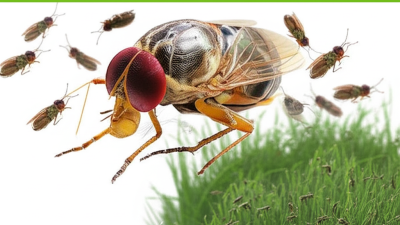
 Bird & Pigeon Pest Control
Bird & Pigeon Pest Control  Mice & Rat Pest Control
Mice & Rat Pest Control  Mole & Vole & Gopher Pest Control
Mole & Vole & Gopher Pest Control  Fly Insect Pest Control
Fly Insect Pest Control  Wasp & Bee Pest Control
Wasp & Bee Pest Control  Moth Pest Control
Moth Pest Control  Mosquito Pest Control
Mosquito Pest Control  Cockroach Pest Control
Cockroach Pest Control  Wildlife Pest Control
Wildlife Pest Control  Snake Pest Control
Snake Pest Control  Bed Bug & Flea Pest Control
Bed Bug & Flea Pest Control  Snail & Slug Pest Control
Snail & Slug Pest Control  Ant & Termites Pest Control
Ant & Termites Pest Control  Spider Pest Control
Spider Pest Control  Other Insect Pest Control
Other Insect Pest Control  Garden Products
Garden Products  Blog
Blog In today's world, insect infestations can pose significant challenges for both residential and commercial spaces, leading to health risks and unsanitary conditions. One of the most effective solutions to combat these pesky invaders is the use of a Disposable Fly Trap. These traps are designed for convenience and efficiency, providing a simple yet powerful means to capture and eliminate flies and other insects. However, choosing the right manufacturer and product is crucial to ensure you are investing in a reliable and effective trap. In this blog, we will discuss key factors to consider when selecting high-quality Disposable Fly Traps, as well as practical tips to maximize their effectiveness in your specific environment. By understanding the importance of quality manufacturing and effective design, you can make informed decisions that will help keep your spaces free from insect infestations.

Insect infestations can occur in various forms, often resulting from common environmental factors. Flies, ants, and cockroaches are just a few examples of pests that can invade homes. Poor sanitation, food debris, and standing water are frequent culprits. These attractions make living spaces a breeding ground for unwanted insects, underscoring the importance of preventative measures.
**Tips:** To minimize the risk of insect infestations, maintain a clean living space by regularly disposing of food scraps and sealing potential entry points. Store food in airtight containers and promptly clean up spills to avoid drawing attention from pests. Additionally, monitoring for standing water around the house can significantly reduce fly populations.
Understanding the specific types of insects present can aid in choosing effective disposable fly traps. For example, knowing whether you're dealing with house flies or fruit flies can help target traps that are most effective for the specific species. Ensuring that these traps are strategically placed in areas where insects are predominantly found, such as kitchens or near garbage bins, can enhance their efficiency.
**Tips:** Always read the instructions on disposable traps to place them correctly. Frequent monitoring and timely disposal of full traps can help maintain control over any insect population and prevent future infestations.
| Insect Type | Common Sources | Best Disposable Fly Trap Features | Effectiveness (%) |
|---|---|---|---|
| House Fly | Food waste, garbage | Sticky surface, food attractant | 85% |
| Fruit Fly | Overripe fruits, vegetables | Fermentation scent, sticky trap | 90% |
| Blow Fly | Decaying material, carcasses | Pheromone lure, high visibility | 75% |
| Drain Fly | Moist areas, clogged drains | Gel bait, sticky capture | 80% |
| Fungus Gnat | Houseplants, moist soil | Soil bait, liquid lure | 78% |
The Science Behind Disposable Fly Traps: How They Work
Disposable fly traps have emerged as one of the most effective solutions for combatting insect infestations, particularly in residential and commercial settings. These traps utilize a blend of attractants and adhesives that entice flies into the device, effectively ensnaring them once they come into contact with the sticky surface. Scientific studies have shown that common household flies can reproduce at an alarming rate; a single female can lay up to 500 eggs within her lifespan. This exponential growth underscores the necessity of employing efficient pest control strategies, such as disposable fly traps, to mitigate infestations before they get out of hand.
Tips: To enhance the effectiveness of disposable fly traps, consider placing them in high-activity areas. This includes locations near food sources, garbage disposals, or any potential breeding grounds. Additionally, maintaining a clean environment by regularly disposing of waste can significantly decrease attractants for flies.
Moreover, it is crucial to understand that while disposable traps are handy, they should be part of a broader integrated pest management approach. Combining traps with sanitation practices and professional pest control services can lead to optimal results. According to the Centers for Disease Control and Prevention, proper pest management not only reduces insect populations but also decreases the risk of diseases transmitted via pests, making it an essential component of maintaining a healthy living environment.
Disposable fly traps have become a popular tool in pest control due to their effectiveness and ease of use. One of the key benefits of using these traps is their ability to help maintain a clean and hygienic environment. Unlike traditional traps that may require handling dead insects, disposable traps can be easily discarded once full, eliminating the mess and the risk of spreading bacteria. This makes them particularly valuable for homes, restaurants, and outdoor gatherings where hygiene is paramount.
Tips for using disposable fly traps effectively include placing them in areas with high fly activity, such as near trash bins or food prep areas. Additionally, ensure that the traps are exposed to sunlight, as flies are attracted to light, increasing the chances of capture. Regularly check and replace the traps as necessary to maintain optimal effectiveness. Utilizing multiple traps can also enhance your pest control strategy, as it covers a wider area and targets various fly species.
Moreover, disposable fly traps are environmentally friendly when compared to chemical pest control methods. They provide a non-toxic solution to insect infestations, making them safe to use around children and pets. Integrating these traps into your pest management routine not only improves the overall effectiveness but also reinforces a commitment to safer, more sustainable practices in combatting unwanted insects.
When it comes to combating insect infestations, choosing the right disposable fly trap can make a significant difference. According to a study by the National Pest Management Association, about 238 million pounds of pesticides are applied annually in the U.S. alone, highlighting the need for effective, non-chemical solutions. Disposable fly traps are designed to attract and capture flies using bait, unlike traditional insecticides, which can pose risks to human health and the environment. Selecting a trap that utilizes a blend of pheromones and food attractants can significantly increase its effectiveness—one report indicates that traps using pheromone lures can capture up to 10 times more flies than standard designs.
When evaluating disposable fly traps, consider factors such as the trap's size, the duration of effectiveness, and its ease of use. A recent industry survey revealed that traps with a longer attraction period—often up to 30 days—are favored by consumers, correlating with higher success rates in fly population reduction. Additionally, ensure the trap is designed for the specific environment—whether indoor or outdoor—as different styles cater to varying conditions. Understanding these parameters can simplify your choice and lead to more effective pest control strategies.
When setting up a disposable fly trap, location is key. Choose an area where flies are most active, ideally near trash bins, compost piles, or any food source. Ensure the trap is placed in direct sunlight, as flies are attracted to heat and light. Additionally, keep the trap a safe distance away from areas where people gather to avoid any unpleasant odors. Monitor the trap regularly to ensure it's working effectively; empty and replace it as needed to maximize its efficacy.
Maintenance is equally important for ensuring the longevity of your fly trap. Make it a routine to check for any signs of wear and tear. If the trap becomes full, be prepared to dispose of it properly and replace it with a new one to maintain a fly-free environment. It can also be beneficial to rotate the locations of traps to prevent flies from becoming familiar with the scent. Combining the use of traps with other methods, such as proper sanitation practices and food storage, will enhance your overall pest control strategy, creating a comprehensive approach to combating insect infestations.

